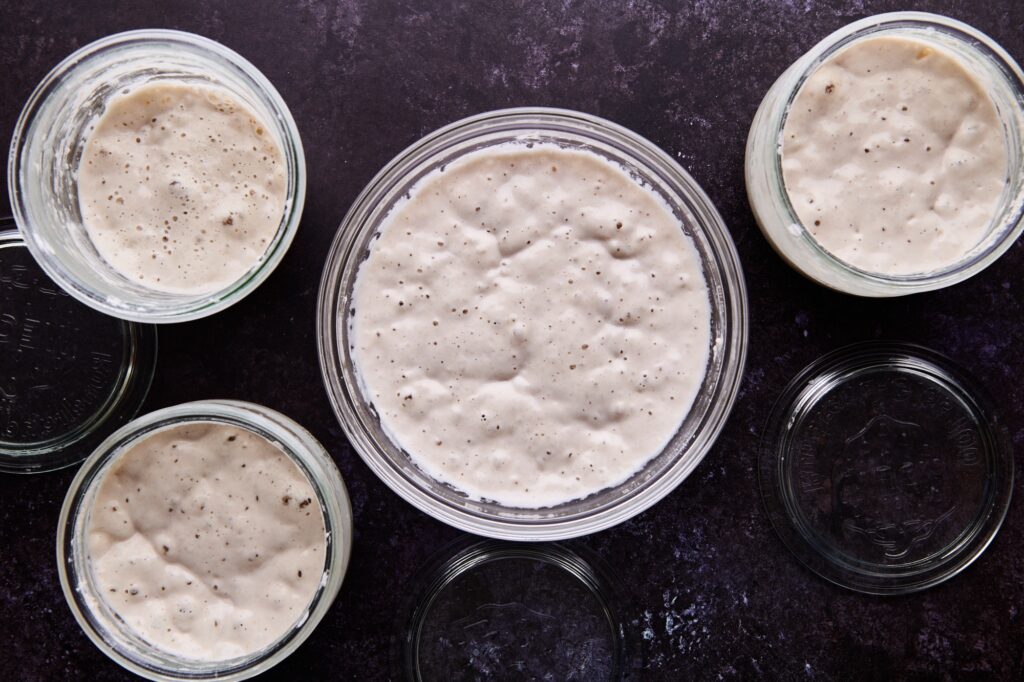
Once your starter is alive and active it only needs to be fed when you want to use it.
Store your starter in the fridge with a fitted lid on in between uses. Your starter stays happily dormant in the fridge, you will see just how magic it is when you take it out of the fridge and it looks flat and inactive, maybe a bit sludgy and dull, and then when you feed it and it gloriously grows and bounces right back.
This may take 2-3 hours in the summer, or 4-5 hours in the winter, your room temperature will have a big effect on how your starter behaves and responds. Warmth will speed it up, cold will slow it down. Watch your starter and see how it behaves for you in your environment, and take a note of its activity, the temperature and timings for future reference.
My video on how to make a starter will explain fully how to use, store and maintain your starter – if you already have a starter you can forward past the actual making part: watch here.
It can be truly hypnotic, you can see why people fall in love with sourdough, and why some people get a bit obsessive about their starters, but what you don’t need to do, is worry about them, they’re very resilient, a lot more so than people realise at first..
As time goes on, you will get a feel for your starter and how strong it is. You will realise that if you forget to feed it for a couple of weeks, or even months, it will be fine. If you’re going to be away for many weeks or months, you can make yourself some back up dried starter if you’re worried, you can feed it up, get it bubbly and active, and dry it out on parchment paper and store it in a jar until you’re ready to reactivate it. Find the full steps and details here.
And the most important part of keeping a starter: give it a name! Mine is called Star.
What you need to know about your starter…
There is a short window of time when your starter is as its ‘peak’, which is when it’s at its most bubbly and active and has grown in volume the most; this is a glorious thing to see. It should be a lovely glutinous consistency, with a thickness like a thick mini pancake batter, and full of bubbles as you stir it. As it goes past this point it will reduce in size again, and become less active, but this doesn’t mean it’s dead, or that it can’t be used, it is still full of the power you need to make dough. As long as it hasn’t become thin or hungry, you can still use it, even if it has dropped back down.
And then next time you feed it it will spring back up again.
In between feeds, whilst your starter is in the fridge, it becomes dormant and sometimes it will look like it’s separated, with a layer of murky liquid on the top often called the ‘hooch’. This is absolutely normal. Just stir it all back together again and use the starter as required.
Only ever keep 100g or less of starter…
You don’t need any more starter than that, keeping your starter lean enables you to feed the whole starter every time your use it, which helps it make it stronger and stronger with every use.
If you try and keep more it will become slow and sluggish and inactive.
If you’ve got more happy bubbly starter than you need on that day, you can make another loaf, use it in other recipes, dry it out and gift it someone else, or merely discard it.
Don’t change the container…
Your starter lives happily in the bowl or jar or whatever you made it in, it does not need to be cleaned and changed, if it’s happy where it is, leave it, don’t disturb it. The bowl does not need to be spotless or pristine, it’s a working vessel. Any dried flour or starter up the sides of the bowl is all good extra power, scrape it off and stir it in.
The ONLY time that the bowl needs changing, or indeed that your starter is at risk, is if it develops mould. In this case, your starter is lost and you will need to make a new one in a clean bowl.
What is ‘discard’?
When you read about sourdough and starters, you will see a lot of discussion about starter ‘discard’; this is the name given to the excess of starter that is generated when making a starter, or from the process of feeding it. It basically means the extra, and if you do generate more than you need, there are lots of recipes for using it in different ways, including some on my blog.
I never have any discard because I keep a base amount of starter that is sufficient to feed it when I need it and I know exactly how much to feed it for my uses, so I ever end up with too much. Sometimes I feed her more than others to be able make more loaves at once or use starter to make something else, like flatbreads or pancakes, but I only ever keep that 100g or less. Which is also what my guide for reviving my dried starter is based on, so that you always end up back at the same amount after feeding and using.
In between uses…
If you’re not going to use it for several weeks, keep it safely stored in the fridge with a firmly fitted lid. It will be perfectly fine and you do not need to take any special action. Many established starters have lived unused in fridges for weeks and months and have been absolutely fine, working perfectly when next used.
Change of plan…
If you got your starter out of the fridge thinking you were going to have time to make some dough up but it turns out you haven’t, just put it untouched back in the fridge. Unless it been a 7-10 days since you used it and it needs feeding, then do as above.
When you want to bake a loaf…
Take your starter from the fridge and let it come up to room temperature. Feed it with 30g of strong white flour + 30g of water, stir it well, and allow it to become fully active and ready to use, this can take 2-6 hours depending on the room temperature. If you feel that the mix feels a bit thin, add a tablespoon more of flour.
Forget ratios
You may have read about needing to feed your starter based on ratios and even quantities of starter, water and flour. This is not necessary. As you will see from above, I feed my starter based on what I need for my dough, NOT based on how much starter is in my bowl, and this works perfectly. I don’t portion any out, and I don’t keep jars of extra unneeded starter. I also give my starter what she needs; for example, if your starter has become thin, and therefore weak, for any reason, give it extra flour to thicken it back up to its previous consistency and strength.
Don’t worry
Most importantly, don’t worry about your starter. It’s very easy to worry about our beloved pots of joy, but they are far more resilient that you may be thinking. Follow the steps and guidelines and it will work perfectly.

Starters can be made with any kind of wheat based flour, this one above is made with wholemeal/wholewheat flour; all of the same tips and notes apply.
For more help visit my frequently asked questions page.
